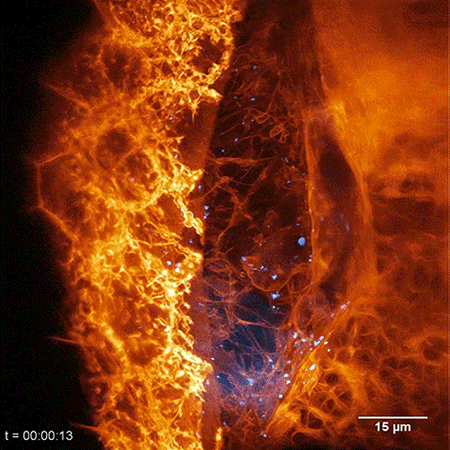16 June 2018
The ability of a liquid to maintain contact with a solid surface is a property called wetting. It is determined by the balance between adhesive and cohesive forces resulting from intermolecular interactions. Adhesive forces cause the liquid to spread across a surface while cohesive forces cause the liquid to ball up and avoid contact. Water-repellant fabrics are an example of non-wetting materials because they minimize interactions between the surface and water droplets.
Electrowetting is a technique to modify the wetting properties of a surface using an external electric field. Dielectric arrays can be used to create microfluidic devices that allow for programatic control of droplet motion. Scientists have used these techniques to perform biological automation and are now exploring the possibility of water-based computer interfaces.
Source: http://tangible.media.mit.edu/project/programmable-droplets-for-interaction/
Learn More: https://doi.org/10.1145/3170427.3186607 ( CHI 2018 )
#ScienceGIF #Science #GIF #Water #Droplet #Programmable #Electrowetting #Dielectric #Engineering #Material #Physics #MIT #Tangible #Media #CHI
View Original Post on Google+
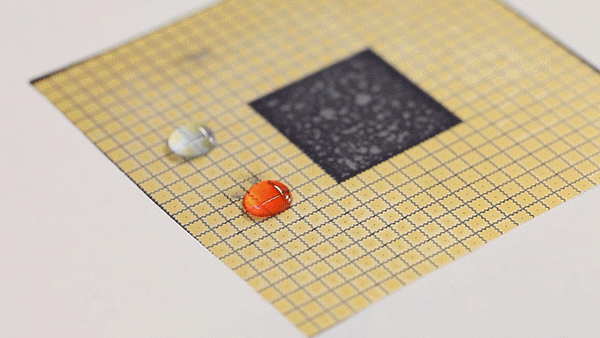
9 June 2018
An alternating current passing through a copper coil induces a magnetic field around the coil per Faraday ‘s Law of Induction. A piece of metal placed within that oscillating magnetic field will experience the opposite effect as an electric current is induced within the metal. These eddy currents passing through the metal induce an opposing magnetic field around the piece of metal and cause it to heat up through a process known as Joule heating. The stronger the change in magnetic field, the more heat generation.
When a piece of aluminum is placed within a magnetic field generated using a 1.6 kW power inverter operating at 204 kHz, it rapidly heats and eventually melts at 660 °C. The molten aluminum reaches a final temperature of 1,200 °C before the current is finally shut off.
Source: https://youtu.be/DkpEz7znpnc
#ScienceGIF #Science #GIF #Induction #Heating #Magnetism #Electromagnetism #Current #Eddy #Metal #Aluminum #Melting #Joule #Faraday
View Original Post on Google+
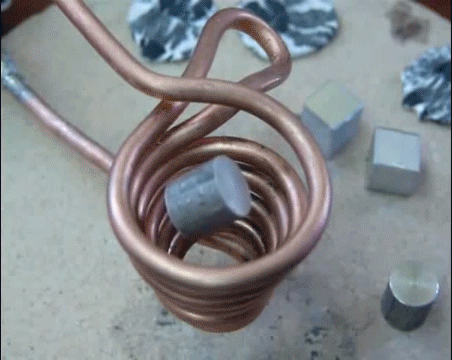
2 June 2018
On March 1, 2018, NASA and NOAA successfully launched GOES-17 , the second in a new series of four highly advanced geostationary weather satellites. Once positioned in its final orbit, the satellite will be renamed GOES-West and provide coverage of the American continent and much of the Pacific Ocean.
This short sequence contains the first images captured by the Advanced Baseline Imager (ABI) on board the satellite. It combines imagery from two visible and one infra-red spectral bands to form a ‘GeoColor’ composite. The new generation of GOES is capable of viewing the Earth across 16 spectral bands and provides 4x the spatial resolution and more than 5x faster coverage than its predecessor.
Unfortunately, the ABI on GOES-17 encountered cooling issues after deployment that severely impairs the performance of 13 near-infrared and infrared spectral bands. It’s unclear what caused the issue and whether it can be resolved.
Source: https://youtu.be/7XlfE0ndv_g (NOAA)
Learn More: https://www.nesdis.noaa.gov/GOES-R-Series-Satellites
#ScienceGIF #Science #GIF #GOES #GOES17 #NASA #NOAA #Hemisphere #Advanced #Baseline #Imager #ABI
View Original Post on Google+
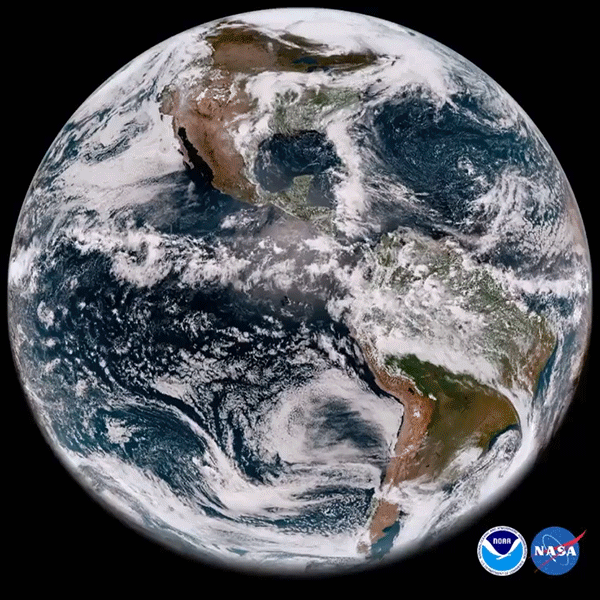
26 May 2018
The Tesla Coil is an electrical circuit invented by Nikola Tesla in 1891 that is used to produce high-voltage, low-current electricity. They are best known for brilliant sparking discharges caused by ionization of the surrounding air by the strong electric field, which allows it to conduct electricity. Ionized gases are also known as plasma , the fourth fundamental state of matter.
Here, a syringe is being used to create a near-vacuum environment that allows the electrons to travel more easily and further than under standard atmospheric conditions. This allows the plasma to persist for much longer than normal.
Source: https://youtu.be/WM25pUsrODk (ElectroBOOM)
#ScienceGIF #Science #GIF #Plasma #Electron #Tesla #Coil #TeslaCoil #Physics #Electricity #Vacuum #Arc #Ionized
View Original Post on Google+
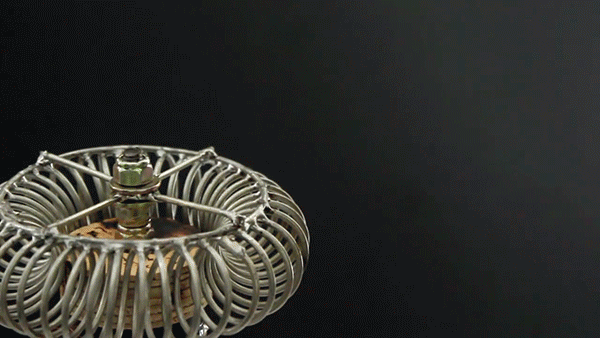
19 May 2018
Faraday ‘s Law of Induction describes how a magnetic field interacts with an electric circuit to produce an electromotive force. It is the fundamental principle behind both electric motors and generators. An important aspect of this is Lenz ‘s Law, which states than when an induced current flows, the resulting magnetic field will always oppose the change that produced it.
Magnetic resonance imaging (MRI) machines produce a strong magnetic field along the central bore where the patient resides. This particular machine has a static magnetic field strength of 3 Tesla, which is approximately 100,000x stronger than that of the Earth’s.
When a piece of aluminum (a non-ferromagnetic metal) is moved through the MRI machine’s magnetic field, it induces an electric current in the metal. Per Lenz’s Law, the magnetic field produced by this induced current opposes the original movement and results in the aluminum slowly falling over.
Source: https://youtu.be/QwUq8xM_8bY
#ScienceGIF #Science #GIF #Magnetism #Electromagnetism #Faraday #Lenz #Law #Physics #MRI #Magnets #Induction #Current #Field #Aluminum #Metal #Force #Electric #Magnetic
View Original Post on Google+
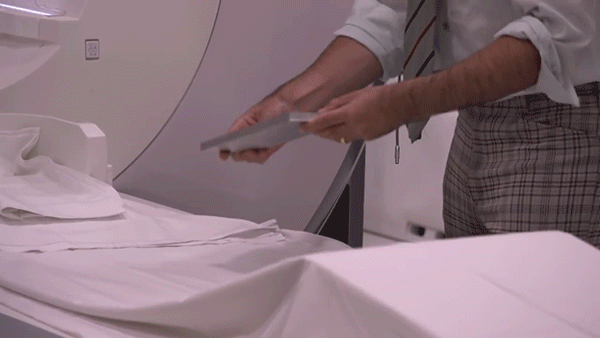
12 May 2018
It’s one of the oldest party tricks: Blowing the bottom off a glass bottle simply by hitting it on the top. When struck from the top, the bottle easily moves downwards while the liquid does not because it has higher inertia. This results in the formation of a near-vacuum environment at the bottom of the bottle (the bubbles). Because this area is now empty, the liquid moves downwards with the full pressure of our atmosphere (101 kPa) through a process called inertial cavitation. The resulting shockwave easily causes the glass to shatter.
Source: https://youtu.be/lj3x2U4CaEs (The Slow Mo Guys)
#ScienceGIF #Science #GIF #Cavitation #Pressure #Slow #Mo #Motion #SlowMo #SlowMoGuys #Vacuum #Inertia #Inertial #Shockwave #Shatter #Glass #Bottle
View Original Post on Google+
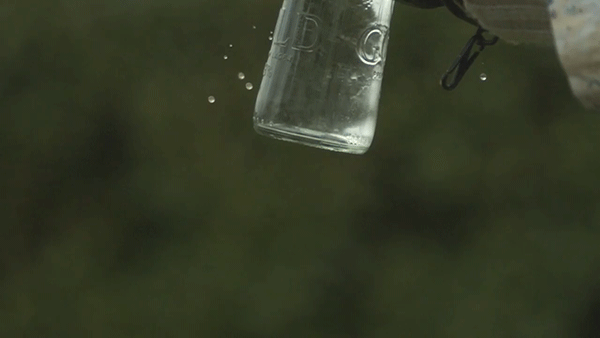
5 May 2018
The reaction of sodium (Na) with water (H2O) is strongly exothermic and forms a colorless solution of sodium hydroxide (NaOH) and hydrogen gas (H2).
2Na + 2H2O -> 2NaOH + H2
During the reaction, the sodium can become so hot it will catch on fire and ignite the flammable hydrogen gas. This can be clearly seen when imaged with a thermal camera.
Source: https://redd.it/86cplg (u/mtimetraveller)
#ScienceGIF #Science #GIF #Sodium #Water #Chemical #Reaction #Thermal #Imaging #Exothermic #Chemistry #Melt #Heat #Hydrogen #Gas
View Original Post on Google+
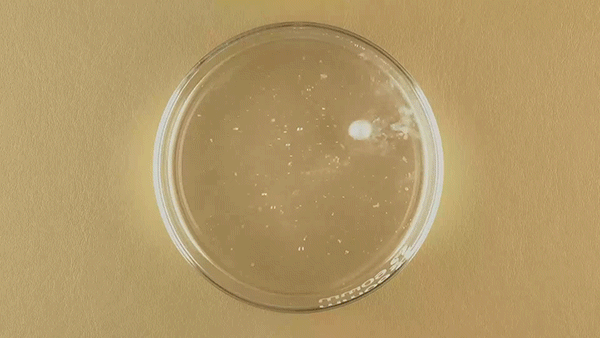
3 May 2018
A new microscope developed at Howard Hughes Medical Institute’s Janelia Research Campus is pushing the limits of optical imaging of living organisms. The system combines adaptive optics , a technique commonly used in astronomy to eliminate distortions, with lattice light-sheet microscopy to produce high-speed, super-resolution imagery of cellular dynamics.
The in vivo development of neural circuitry in the spinal cord of a zebrafish embryo was imaged using the technique. The imaged volume spans 60 x 224 x 180 μm and was acquired over 12 hours. Newly differentiated neurons are highlighted using Autobow fluorophore labeling while older neurons are labeled with mCherry (magenta). The development of rostrocaudally projecting axons can be seen over time across the bottom.
Source: https://goo.gl/VAocpQ ( Science )
Learn More: https://goo.gl/XHYSst (HHMI)
#ScienceGIF #Science #GIF #Biology #Microscopy #Microscope #Zebrafish #Embryo #Spinal #Cord #SpinalCord #Fluorescence #Fluorescent #Lattice #LightSheet #Light #Sheet #SLM #Mirror #2P #Super #Resolution #Modulation #Betzig
View Original Post on Google+
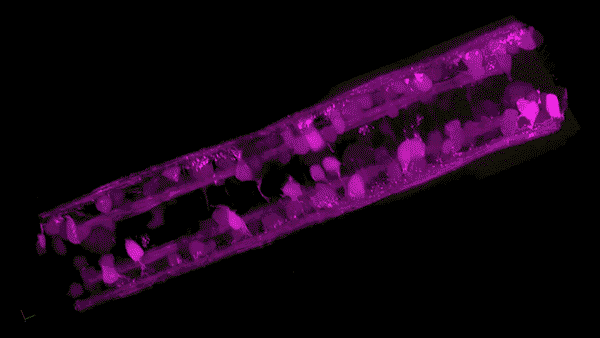
28 April 2018
Previously unreleased imagery from the European Space Agency’s Rosetta spacecraft reveal ice and dust on the surface of Comet 67P/Churyumov-Gerasimenko. The images were captured on June 1, 2016, over the course of 25 minutes at an altitude of roughly 13 km above the surface of the comet. Comet 67P is a Jupiter-family comet originally from the Kuiper belt and has an orbital period of 6.45 years.
The majority of the “snow” is actually caused by cosmic rays hitting the camera sensor and saturating pixels. These high energy particles pervade the Universe and originate from extrasolar phenomena such as supernovae, galactic nuclei, quasars, and gamma-ray bursts. The Earth ‘s atmosphere protects us from the deleterious effects of cosmic rays.
Source: https://twitter.com/landru79/status/988490703075463168
#ScienceGIF #Science #GIF #Comet #67P #Comet67P #Rosetta #OSIRIS #Probe #Cosmic #Ray #CosmicRay #Stars #Snow #Dust #Churyumov #Gerasimenko #ESA #Space #Exploration #Discovery #Lander
View Original Post on Google+
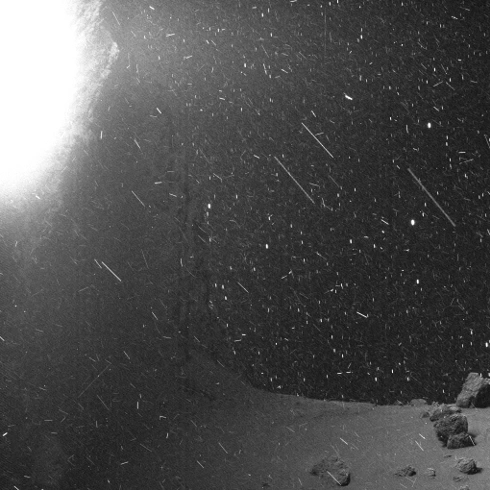
26 April 2018
A new microscope developed at Howard Hughes Medical Institute’s Janelia Research Campus is pushing the limits of optical imaging of living organisms. The system combines adaptive optics , a technique commonly used in astronomy to eliminate distortions, with lattice light-sheet microscopy to produce high-speed, super-resolution imagery of cellular dynamics.
Here, a neutrophil (white blood cell) can be seen internalizing small granules of sugar via phagocytosis within a developing zebrafish embryo. The larva has been genetically modified to express the fluorescent protein Citrine in the plasma membrane of all its cells. Dextran particles labeled with the fluorophore Texas Red were injected into the blood stream and then imaged as they prompted an immune response.
This extraordinary view of cellular behavior within a living organism is one of many remarkable videos reported in Science last week alongside the new microscope.
Source: https://goo.gl/VAocpQ ( Science )
Learn More: https://goo.gl/XHYSst (HHMI)
#ScienceGIF #Science #GIF #Biology #Microscopy #Microscope #Zebrafish #Embryo #Neutrophil #Immune #Cell #Phagocytosis #Sugar #Dextran #Fluorescence #Fluorescent #Lattice #LightSheet #Light #Sheet #SLM #Mirror #2P #Super #Resolution #Modulation #Betzig
View Original Post on Google+
